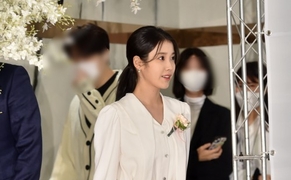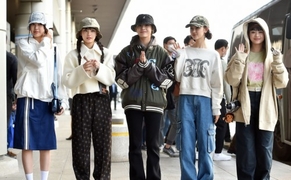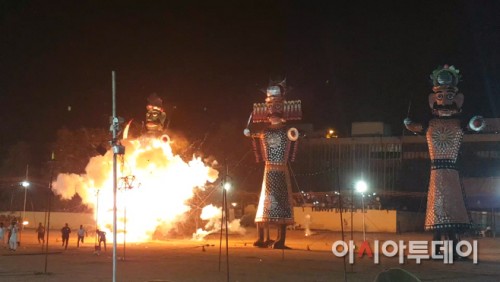 The burning of Ravana effigies takes place as final part of Dussehra festival in India./ Photographed by Jeong In-seo The burning of Ravana effigies takes place as final part of Dussehra festival in India./ Photographed by Jeong In-seo |
By Jeong In-seo, New Delhi correspondent, AsiaToday – Dussehra, a major Indian festival where people burn the demon king Ravana, was celebrated across India on Tuesday.
As a reporter, I headed to Ramlila Maidan located in the center of New Delhi to enjoy the festival. On my way, I was able to meet 10 gigantic effigies of the demon king Ravana.
 The 20 meter tall Ravana effigies are built during Dussehra festival./ Photographed by Jeong In-seo The 20 meter tall Ravana effigies are built during Dussehra festival./ Photographed by Jeong In-seo |
Dussehra is one of the three major festivals in India along with Holi and Diwali. The celebration of Dussehra is rooted in the Indian epic of Ramayana, which tells the story of King Rama leaving his Kingdom to rescue his wife Sita, who had been kidnapped by Sri Lanka's demon king Ravana. King Rama fights with the demon all of nine days and ten nights. On the tenth day, he kills the demon and rescues his wife. Marking the victory of King Rama over the demon Ravana, Dussehra is celebrated on the tenth day of the month Ashvin, the seventh month of the lunisolar Hindu calendar that overlaps September and October of the Gregorian calendar, every year.
When I arrived at the Ramlila Maidan, the first thing I noticed was the gigantic demon effigies. The three gigantic demon effigies of 20 meter tall were standing in the ground. Safety fencing were installed on the venue, while security guards and police were deployed to avoid the crowd coming forward.
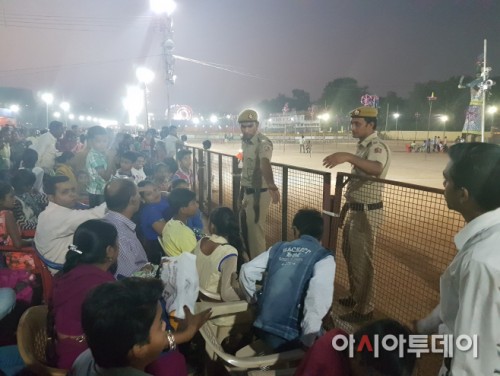 Safety guards and police control people during Dussehra celebrations for safety reasons./ Photographed by Jeong In-seo Safety guards and police control people during Dussehra celebrations for safety reasons./ Photographed by Jeong In-seo |
Amit Gupta, a 26-year-old police officer from Delhi, asked me to go backward for safety reasons. He said, "Nearly 30 people were killed in a stampede during Dussehra celebration last year. We are controlling people to make sure that sort of tragedy won't happen again."
At 6 p.m., a play was performed on the stage. The play, entitled "Ramlila", recalls the battle between Rama and Ravana, and is listed as World Heritage by the UNESCO.
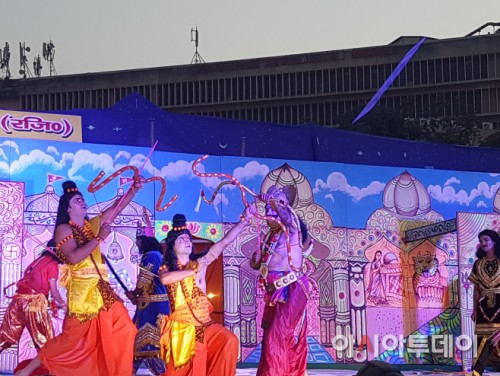 A scene of King Rama shooting arrows from annual "Ramlila" at Ramlila Maidan, New Delhi./ Photographed by Jeong In-seo A scene of King Rama shooting arrows from annual "Ramlila" at Ramlila Maidan, New Delhi./ Photographed by Jeong In-seo |
After about an hour, the highlight of the festival finally arrived. King Rama threw the torch to the gigantic demon effigies that were 20 meter tall. The effigies burned to ashes amid loud busting of crackers and shouting by crowds of people, ""Bharat Mata ki Jai!" ("Victory for Mother India").
After the show ended, I met a family who did not leave the venue. Mr. Deepark, 42, said he came to the venue with his family. He said, "I came here to show my daughter the victory of good over evil." He added, "Dussehra isn't just a festival for Indians. It's an important ritual symbolizing the victory of good over evil."
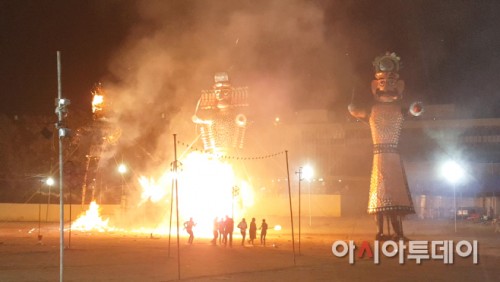 The burning of effigies during Dussehra festival./ Photographed by Jeong In-seo The burning of effigies during Dussehra festival./ Photographed by Jeong In-seo |
Most Read
-
1
-
2
-
3
-
4
-
5
-
6
-
7



















